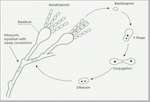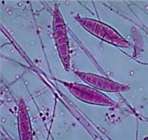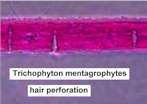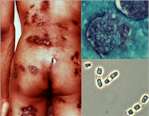..
CHAPTER 16: FUNGAL PATHOGENS OF HUMANS
the
major fungal pathogens of humans and other mammals
In contrast to the many thousands of fungi that infect plants, only about 200-300 fungi are reported to cause diseases of humans and other warm-blooded animals – diseases that are collectively termed mycoses. We can be thankful for this, although it remains to be explained satisfactorily in evolutionary terms. Even the fungi that do infect humans and other warm-blooded animals are, for the most part, opportunistic or cause only mild symptoms in normal, healthy individuals. But the situation has changed drastically in recent years, with the increasing use of immunosuppressant drugs in transplant surgery and cancer therapy, and the advance of HIV/AIDS. Fungal infections can be life-threatening in these situations, and we shall see in Chapter 17 that there are few really satisfactory drugs to control them without causing adverse side effects. In addition to the invasive mycoses, fungi pose a threat to health by producing mycotoxins in foodstuffs and animal feeds (Chapter 7), and airborne fungal spores can be significant causes of asthma, hay fever and more serious occupational diseases, discussed in Chapter 10. Taking all these factors together, fungi can have a significant impact on human and animal health. In this Chapter we consider the major fungi that infect humans and some other warm-blooded animals. The human-pathogenic fungi can be grouped into five categories based on features such as their primary route of entry into the host, the type of disease that they cause, and their natural sources of inoculum. An outline of these groups is given below and will provide the basis for more detailed treatment in later sections of this chapter. 1. The dermatophytes, also known as ringworm fungi, grow in the dead, keratinised tissues of the skin, nails and hair. They are very common, and infect large sections of the human and animal populations. The diseases that they cause are superficial, being confined to the dead tissues, but they can cause severe irritation of the underlying living tissues, leading to secondary invasion by bacteria. Many of these fungi show a degree of specialisation for particular hosts (humans, cats, cattle, etc.) but can cross-infect other hosts. The source of inoculum is usually the shed keratinised tissues (flakes of skin, hairs, etc.) in which the fungus can persist in a dormant phase. As a group, the dermatophytes are successful parasites with a clearly defined niche. 2. Several Candida species grow as normal resident commensals on the mucosal membranes of healthy individuals, but can become invasive in appropriate conditions. The diploid yeast Candida albicans is the prime example of this. It is found commonly on the mucosa of the gut, the mouth and the vulvo-vaginal tract. But in response to environmental triggers the yeast cells can produce hyphal outgrowths that invade the mucosa, leading to clinical or sub-clinical conditions. For example, ‘thrush’ is a white, invasive speckling of the throat, which is common in neonates and immuno-compromised individuals, including AIDS and cancer patients, and people in the advanced stages of diabetes. Candida can also cause intense irritation of the vulvo-uterine tract of women during stages of menstruation or during pregnancy, and it commonly causes stomatitis in people who wear dentures. 3. A diverse group of fungi that normally grow as saprotrophs in soil or on plant or animal remains can establish infections in the lungs from inhaled spores. These infections invariably stem from an environmental source of spores rather than from direct patient-to-patient transmission. Almost any fungus that produces spores small enough (c. 3-4Ám) to reach the alveoli, that can grow at 37oC, and that can withstand the host’s cellular defences is a potential threat to health. But these infections are normally restricted to immunocompromised or immunosuppressed individuals, including patients with advanced diabetes or cancers. A notable feature of many of these infections is that they are geographically confined to specific regions – in other words, they are endemic. For example, Coccidioides immitis (a fungus known to have killed a laboratory worker) is largely confined to the arid desert regions of south-western USA and northern Mexico. 4. A few fungi with melanised hyphal walls, such as species of Phialophora, Cladosporium and Sporothrix, can invade traumatised tissues such as deep wounds and cause tissue-degrading lesions. Although they can be important causes of infection, especially among agricultural workers in the poorer countries, they are essentially pathogens of wounds or traumatised tissues. They are not considered further in this chapter. Similarly, some common members of the Zygomycota cause traumatic infections of people who suffer from diabetes and ketoacidosis, as discussed in chapter 2. 5. A specialised group of primitive fungus-like organisms, now classified as different species of Pneumocystis, are found in the lungs of humans and a wide range of mammalian hosts. They seem to be host-specific because DNA sequence comparisons of Pneumocystis strains from different hosts show wide genetic diversity, but close similarity between strains isolated from any one type of host. The fungus that infects humans, Pneumocystis jirovici (formerly known as P. carinii), seems to be particularly common in young children, because often more than 80% of children show an antibody response to the pneumocystis antigen in skin tests. But the fungus seems to disappear as children age, and is found again in AIDS patients, where it causes a virulent pneumonia that can be transmitted from patient to patient by airborne cells. Pneumonia caused by P. jirovici in HIV patients is often regarded as one of the first “AIDS-defining” illnesses.
----------------------------
----------------
|
||||||||||||||||||||||||||||||||||||||||||||||||||||||||||||||||||||||||||||||||||||||










